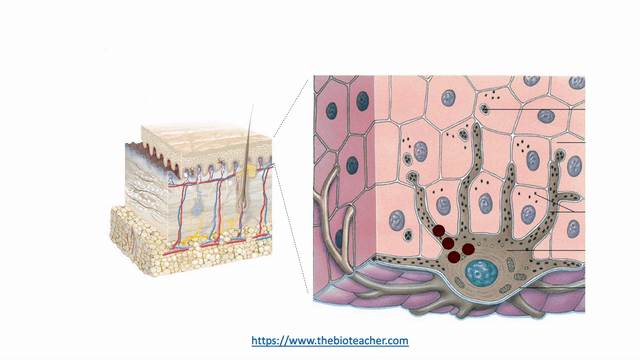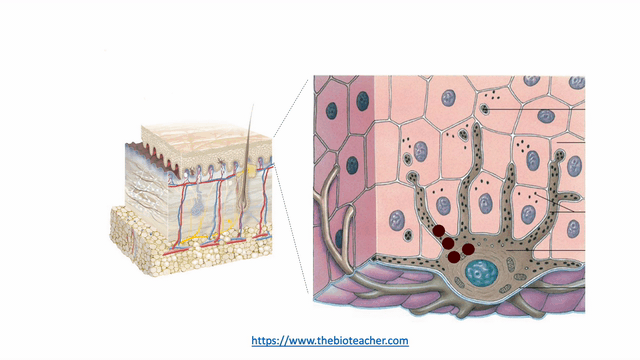
28 Jul DOES OUR SKIN PROTECT US FROM UV LIGHT? HOW?
A few words about one of the most important organs of human body: The skin
The skin is our largest and most visible organ, covering nearly 2 m2. As the interface between the organism and the environment, the skin has a multitude of functions; from maintaining temperature homeostasis and serving as the first line of defense against pathogens to performing important metabolic processes and protecting against the harmful effects of Ultraviolet Radiation (UVR). It is therefore a highly complex organ made of many cell types and can be divided into three main layers. The epidermis (outmost layer), the dermis (middle layer), and the hypodermis(innermost layer) (Figure 1).
The epidermis is comprised mostly of keratinocytes (90–95%) and a few melanocytes and can be sub-categorized into further layers (Figure 2). Keratinocytes, located in the innermost basal layer (stratum basale), migrate up towards the surface of the skin in a process called keratinization (or cornification) (Figure 2). Keratinization ultimately gives rise to the outermost layer of the epidermis (stratum corneum) that is composed of dead (keratinized or terminally differentiated) keratinocytes (Figure 2). These cells form a flattened-sheet structure that provides a mechanical and biochemical barrier, protecting the underlying cells (Figure 2).
The dermis is the middle layer of the skin and provides mechanical support for the whole skin tissue since it is mostly made of connective tissue and specifically collagen and elastic fibers (Figure 1).
The hypodermis is the deepest layer of the skin providing insulation and support to the upper layers of dermis and epidermis (Figure 1). The skin’s innermost subcutaneous region is primarily composed of adipose-rich tissue and accommodates nerves, as well as blood and lymphatic vessels (Figure 1). Vessel capillaries extend up to the epidermis in order to provide nutrients, oxygen, and thermoregulation.
Adapted from https://int.eucerin.com/about-skin/basic-skin-knowledge/skin-structure-and-function
Which cells protect us from UV radiation and how?
These are the melanocytes, which are dendritic cells (meaning literally branched and originating from the Greek word: dendro, δένδρο: tree) located on the border that separates dermis from epidermis (outer skin layer), called the basal layer (or basement membrane) (Figure 1, Figure 3). These cells produce and secrete the natural pigment melanin in specialized organelles called melanosomes (Figure 3). Upon UV irradiation, more melanin is produced by melanocytes, and the pigment is delivered through the dendrites to neighboring keratinocytes (Figure 3). Melanin creates cup-like structures on the keratinocytes’ nuclei providing protection from the damaging irradiation (Figure 3).
While melanocytes’ main bodies lie between the basal layer and the stratum basale of the epidermis, their dendrites extend up to the stratum spinsosum and reach many keratinocytes (Figure 2, Figure 3). Together, keratinocytes and melanocytes form a melanin unit in which melanocytic dendrites contact up to 40 keratinocytes. Pigment-containing melanosomes are first moved to the tips of melanocytic dendrites and then transported to neighboring keratinocytes, where melanin forms supranuclear ‘caps’ shielding and protecting DNA from UVR (Figure 3).

A bit more about melanin…
Melanin protects our skin from light in several ways. Besides shielding the nuclei of the skin cells (keratinocytes) containing the ‘precious’ DNA (Figure 3), it also absorbs and re-distributes the light energy from UV rays. Light skinned people are more likely to develop skin cancer than individuals with dark skin, which suggests that pigmentation is a key risk factor in skin cancer. Intriguingly, the difference lies not in the number of melanocytes, but in the amount of melanin produced. Asian individuals have, on average, two-fold more melanin than Caucasian people, while Africans have around three- to six-fold more melanin. Melanin, like sunscreen, has a sun protective factor (SPF) of 2–4. An SPF of 2 represents doubling the amount of protection from the sun. This means that melanin absorbs or re-distributes around half of the UV light one is exposed to.
Melanin pigment comes in two forms; the dark brown/black eumelanin and the red/yellow pheomelanin. The two types of melanin are synthesized in all human melanocytes, independent of the pigment of the skin. As said earlier, what differs between individuals with different skin colors is not the amount of skin melanocytes but rather the amount and the ratio of eumelanin/pheomelanin produced. Eumelanin is the type of melanin that dark-skinned individuals have more of, while no differences have been detected for pheomelanin (all races have it).
Besides the intrinsic protection we get from our own melanin and independent of our skin type, it is important not to forget the good practices of 1. avoiding direct sun exposure between 11–15 pm, when the UV rays are strongest, 2. covering our body (head to toes) when we spend time outdoors, either during high UV emissions or on a high altitude (as more UV rays reach us at higher elevations), 3. keeping in mind that UV rays can get through clouds and last but not least enjoy our life having common sense.



Sorry, the comment form is closed at this time.